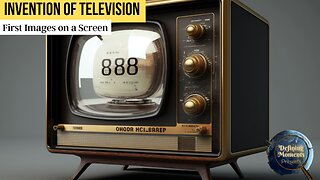"HOW TELEVISION WORKS" 1952 Educational overview
031222 Like and subscribe. This is an archive, check the link in the end if you are owner. "How Television Works" 1952, is an educational overview, restored for discussion and comment. It provides a fascinating look at how television works from the camera tube to the picture tube. It provides a fascinating very basic description back when Television was a very new thing to most people. The television seen in the film is the Bush 9" table top television receiver, manufactured by Bush Radio Ltd. It appears to be a model TV22 or the earlier TV12 (1948). Topics in the film include TV vacuum tube electronics, broadcast, antennas, iconoscope, CRT picture tube, early television transmission, amplifiers, electron gun, TV signal transmission, etc. Shows a British couple watching a very early TV in their home, plus illustrations of how the camera and electron gun work. Very easy to follow. Good quality film!
2k and 4k stock footage available from
http://www.periscopefilm.com
Original Bush model TV-12 television (1948) was a landmark television introduced in 1948 and had a 9 inch screen, with a Bakelite case. The model TV22 looked nearly identical.
About the Bush TV22 model: (from the Science Museum Group, UK) -
"A Bush TV22 9" table top television receiver, manufactured by Bush Radio Ltd about 1952. Fitted after manufacture with a Band III convertor.
Featuring a 9 inch screen the Bush TV22 was first made in 1950. It remained in production (with circuit improvements) for several years, and in 1955 a Band III converter was produced which could be fitted to existing sets to enable them to receive the new ITV programs.
The TV22's main claim to fame is that it was the first British television that could be tuned by the owner to any one of the two then current BBC transmitters as well as the further three proposed channels.
The Bush TV22 is an icon of early 50s Bakelite sets and highly desirable today, although in its day it was one of the cheapest sets available (at £35 and 10 shillings) - it was intended for those who couldn't afford a set with a 'proper' wooden cabinet. The post-war timber shortage was the main reason why some TV manufacturers used other materials for the cabinets."
Source: Science Museum Group
https://collection.sciencemuseumgroup.org.uk/objects/co241620/bush-tv22-television-receiver-1952-television-receiver
https://rumblevideoarchive.wordpress.com/
-
 1:00
1:00
C405ULTRA
1 year agoMainstream TV Educating Children
8 -
 16:23
16:23
Education in America Series
10 months agoEducation in America-Part 11: Simpsons on Education and Modern Educayshun
55 -
 1:19
1:19
chycho
1 year agoAll Information on This Channel Is for Educational Purposes Only: Live Your Life As You See Fit
142 -
 13:43
13:43
Someguy827 Archives
1 year agoI really don't like modern Television
10 -
 4:06
4:06
Defining Moments
1 year agoInvention of the Television: How It Impacted Society and Revolutionized Entertainment | TV | HD
55 -
 37:07
37:07
TECNTV.com
1 year agoTECNTV.COM / Education: The Great American Struggle for Freedom and Success
27 -
 20:30
20:30
EmpowerUAmerica
1 year agoDiscussion on the Documentary " Truth and Lies in Education"
35 -
 1:03
1:03
Brackpool
1 year agoChannel 4's New "Education" Series is INNAPROPRIATE
4 -
 43:25
43:25
TECNTV.com
1 year agoTECN.TV / Homeschooling: What Has Public Education Accomplished For Your Child?
23 -
 1:21:37
1:21:37
NaysGarden
1 year agoVALUETAINMENT IS SOMETHING YOU MIGHT WANT TO START WATCHING!
48